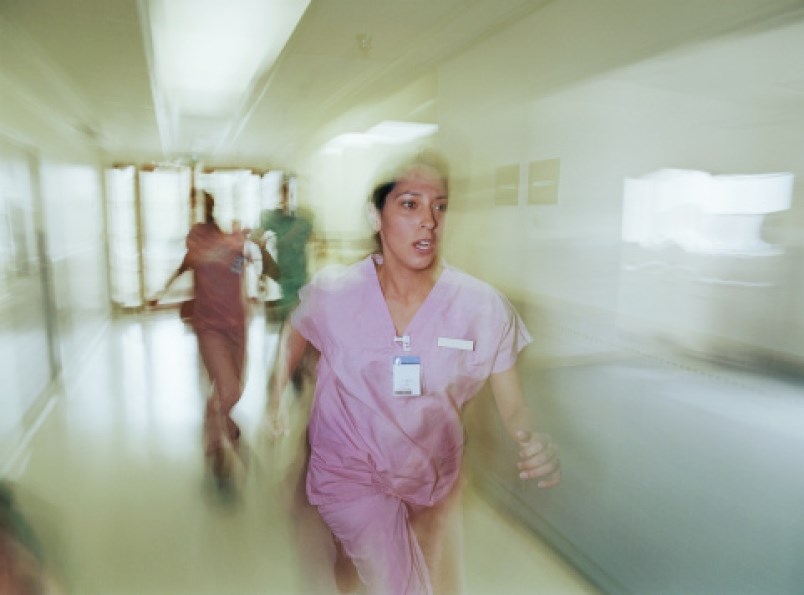Workplace violence isn't much of an issue for most workers – but it's still an issue that needs addressing in many fields.
The latest call for better protection of workers from violence is in health care.
The B.C. Nurses’ Union is calling for security in every unit at the Forensic Psychiatric Hospital in Coquitlam after two nurses were recently assaulted. One was treated for severe facial injuries while the other suffered head injuries after being sucker-punched.
This is not a new request, though, as the nurses’ union has been asking for more help to prevent violence in the workplace for several years.
The Forensic Psychiatric Hospital in Coquitlam has been identified as one of the four most violent work sites in health care, with patients waiting who have been deemed too at-risk to be in public, or patients awaiting a diagnosis, explained Christine Sorensen, president of the B.C. Nurses’ Union.
“If they’re at risk to the public, they’re at risk to staff,” she said, adding that these are the most clinically challenged patients. “Nurses go to work with the intent to provide the best possible care.”
Sorensen said the nurses from the forensic unit tell her that they see violence on every shift, from being pushed, yelled at or pinched.
Having protection officers, security guards, on each unit, would help de-escalate situations that might potentially harm the health-care staff.
“I don’t think it’s too much to ask to protect the health and potential life of your staff,” Sorensen said.
Statistics from WorkSafeBC show that the health care and social services sector has the most claims resulting from violence in the workplace. Over a 10-year-period, from 2006 to 2015, there were 9,231 violence-related claims filed with WorkSafeBC by health care and social service workers, which accounted for more than 60 per cent of all violence-related claims to the provincial body. The sector experiencing the second highest level of violence was education, but this only accounted for eight per cent of violence-related claims.
Nurses aides, healthcare assistants and patient-service associates accounted for 41 per cent of all health care/social services violence claims, while 18 per cent of claims came from registered nurses and registered psychiatric nurses. Social and community service workers also accounted for 18 per cent, while licensed practical nurses accounted for 13 per cent of violence-related claims.
WorkSafeBC includes in these statistics people working in hospitals, long-term care facilities, home and community care, ambulances, transition homes, facilities dealing with at-risk youth and counselling and other related social service jobs
In 2015, of the 9,165 total health-care claims by health care and social service workers, 13 per cent were related to violence. Claims from this sector accounted for 63 per cent of lost-time claims.
Sprains and strains to the back, shoulders and wrists are the most common type of injury, accounting for two-thirds of the total, and this resulted largely from kicking, hitting or beating.
Sorensen said her union has been sounding the alarm on violence in health care since 2014, and she is “disappointed” that more hasn’t been done by the provincial government despite promises.
Sorensen said some employers have expressed concerns that having protection officers in the units would interfere with the therapeutic care, but she said a protection officer could help de-escalate and regain control of the situation.
For too long, government, health authorities and even societies have asked, “isn’t this part of your job?”
“It is not part of a nurse’s job to be assaulted – or any health care worker,” Sorensen said.
In addition to the four top-priority worksites, the BCNU has identified six other sites for violence prevention, including Royal Columbian Hospital in New Westminster.
The other five are Mills Memorial in Terrace, The Views in Comox, Royal Jubilee in Victoria, Penticton Regional Hospital and Hilltop House, a long-term care facility in Squamish.
Kendra Strauss, a director and associate professor of the Labour Studies Program at SFU, said with an aging population, acute care needs have increased and are complex.
As part of a study of workers in aging cities, researchers are hearing that workers say they are rushed and short-staffed, Strauss said. This causes stress for the patients and may cause them to lash out.
“The issues of violence is being raised by workers themselves,” Strauss said.
They need to be able to establish routines and maintain those routines as well as have stability in staffing to minimize the impact to patients, Strauss added.
According to the Provincial Health Services Authority, security has been increased at the forensic facility in Coquitlam, and they will be investing more in staff training and safety.
Each incident at the facility is reviewed to see what happened and why, said Dr. Connie Coniglio, COO of Complex Mental Health and Substance Use at the B.C. Mental Health and Substance Use Services.
“We do everything we can to keep our staff, physicians, and patients safe, including providing a full range of support for anyone involved in an incident to ensure his or her needs are met addressed,” Coniglio said.
– Maria Rantanen, North Shore News


